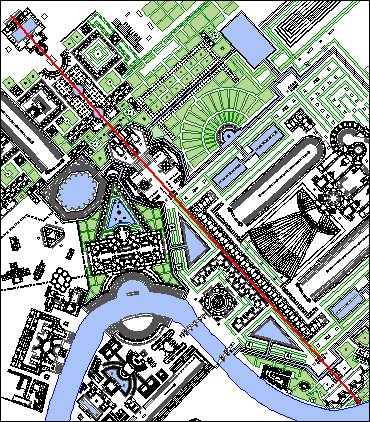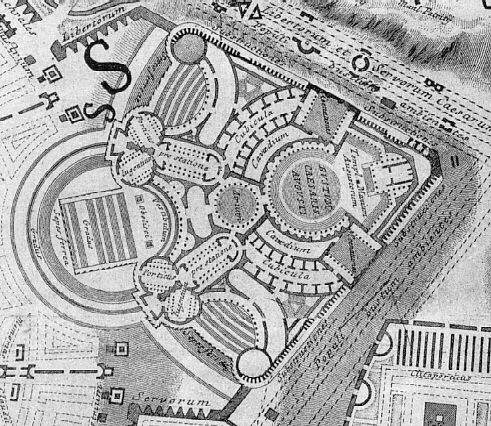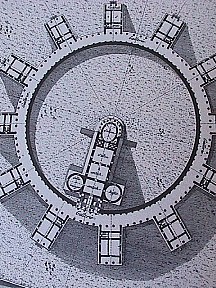sex, Mars, reenactment
1997.11.20
...the phrase, "back to daddy's balls, architecture halls"... ...a connection between this line and the Ichnographia. ...Mars being the father of Romulus--the founder of Rome, and the connection of sex and conception within plans... ... the "testicles" of the Templum Martis as generators...
...the prominence of Mars... ...Piranesi actively redesigned Imperial Rome as he came to understand it. Piranesi assimilated all the knowledge about this part of the city, and through that assimilation he delineated an optimal synthesis. Piranesi's plan of the Campo Marzio is not an architectural reconstruction, but an archeological redesign. Piranesi's plan is not a rendition of what was, rather a rendition of what could have been. Piranesi's plan is not a reconstruction, but an historical reenactment.
The Ichnographia is a powerful reenactment of the architectural history of the Campo Marzio. The history, moreover, is not limited to Imperial Rome. Although the buildings are named for those primarily of the late Empire, Piranesi also very cleverly and extremely subtlely reenacts the architectural history of the Campo Marzio beyond the Imperial Age, specifically the inversion/conversion of Rome from pagan state to Christian state.
The opening stage for the reenactment is the Scenographia (whose very title has obvious theatrical connotations)...
...regarding the Ichnographia as a stone fragment: a reenactment of the Forma Urbis--a virtual reenactment of discovering the great missing piece of the "puzzle" that will bring all the other piece to a grand cohesion. (...here reminded of Tafuri's opening comments to The Sphere and the Labyrinth: "There comes a moment (though not always) in research when all the pieces begin to fall into place, as in a jig-saw puzzle, where all the pieces are near at hand and only one figure can be assembled (and thus the correctness of each move be determined immediately)..."
| |
Mars (Martis)
1998.07.23
The second temple of Mars, positioned on the west side of the Tiber at the foot of the Vatican Hill, sits within a hexagonal area labeled Apparatorium Triumphatorum -- the place of preparation for the triumphal march. In front of the temple and place of preparation is the decagonal Area Martis, which an euripus (canal/moat) encloses on two sides, and it is here that Piranesi indicates the beginning of the Triumphal Way. Besides the obvious ceremonial importance of the Area Martis, this place is also distinct within the Ichnographia: its ten-sided perimeter is the only such shape throughout the entire large plan. Significant also is the plan of the Templum Martis, whose ichnography resembles male genitalia. The deliberate connection between Mars and overt masculinity is unquestionable. Moreover, the Templum Martis, the Area Martis, and the beginning of the Triumphal Way together establish a principal axis, one of the three major axes present within the Ichnographia. This axis extends from the top of the Vatican Hill straight down to the bank of the Tiber across from the tomb of Augustus, and is not only great in length, but also rich in symbolism. Represented here is the mighty thrust of Mars, the dominance of Romulus, and hence the source of Rome and its unparalleled pride.

| |

The Templum Martis (top) is surrounded by a hexagonal place reserved for the preparation of the triumphal march. The Area Martis (below) is a large space in front of the Templum Martis and the place where the Triumphal Way begins (indicated in red).
The long axis running through the Templum and Area Martis (center) extends from the Nympheum Neronis atop the Vatican Hill (upper left) down to another Nymphaeum on the west bank of the Tiber (lower right).
|
Sexual Architecture??
2005.04.29 12:59
Ledoux's proposed plan for a brothel for Chaux, which reenacts part of Piranesi's plan of the Bustum Caesaris Augusti within the Ichnographia Campus Martius.

Giovanni Battista Piranesi
Bustum Caesaris Augusti
within the Ichnographia Campus Martius
1757-62

Claude-Nicolas Ledoux
Maison de Plaisir
c. 1789
|

Claude-Nicolas Ledoux
Oikèma
1789
|
|